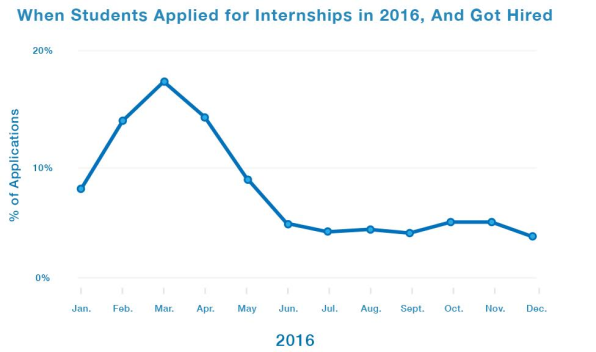March is the busiest and most crucial month for internship applications; here’s how to stand out and land a summer gig.

According to data by LinkedIn, more summer interns are hired in March than any other month of the year.
There were 70,000 U.S. internship listings on the professional networking site in February. If historical trends are any indicator, that number will likely jump above six figures during the month of March.
“It is the dead center of internship season; it is a crucial month,” says Lauren Berger, founder of Internqueen.com and author of two books on interning, including All Work, No Pay and Welcome to the Real World. “If you don’t have those materials ready, sit down this weekend, block out some time, give those materials a facelift, go over your resume and your cover letter, and make sure you’ve got some references ready to go.”
How To Get An Internship Without Experience
It can feel like a catch-22: Experience is required to get an internship, but an internship is required to gain experience. But Berger says it’s not too late for students to beef up their resumes by signing up for some additional school clubs and committees.
“That’s one of the best ways to get something on your resume,” she says, adding that students should target clubs that are most relevant to the internships they’re applying for. “We’re not too far off from the beginning of spring semester at a lot of universities, a lot of clubs are only two or three meetings in, so you can still try and sign up.”

While those opportunities are still available, they won’t be for long, and soon internship opportunities will begin to disappear as well. In 2016, LinkedIn saw relatively flat internship application rates from June through the New Year before a peak in March that fizzled out again by May.
“Through the data, we know they should be looking for internships in metro areas,” adds LinkedIn’s senior product manager for students, Kylan Nieh. “The top five cities, purely based on the number of internships available, are New York, San Francisco, Minneapolis, San Jose, and Santa Monica.”
How To Make Your LinkedIn Profile Stand Out
The professional network’s data also reveals a number of ways students can increase their chances of landing a summer gig through their online profile. For example, LinkedIn profiles who list their location receive 19 times more views, and those who list five or more skills are 27 times more likely to be discovered in searches by recruiters.
“Even if you don’t have former internship or work experience, if you have club and activity experience, or other leadership experience within your school, make sure you highlight that in your profile,” says Nieh. “Highlight the courses you’ve been taking, highlight the projects that you think would best represent the skills you’ve acquired through your academic journey, and that employers might get excited about. Those are ways students can help themselves stand out.”
Nieh adds that the summary section is more crucial for students than most applicants, as it gives them an opportunity to showcase some of their skills and interests, even if they don’t have formal work experience in those areas.
Pay Attention To The Details
While March can be a very competitive month for internships, Berger says that interns who take the time to follow directions and fill out an application properly are already ahead of the pack.
“While they do get a lot [of applications], if I were to take out all the resumes that aren’t done properly—because of formatting, because of spelling errors, because the resumes aren’t arranged properly or saved as PDFs, because they didn’t add a cover letter when they were supposed to, whatever it might be—they’re actually not left with that many,” she says.
Berger adds that it is not uncommon for internship coordinators to receive cover letters addressed to the wrong company.
“Print off the internship listing and go through it with a highlighter, because they are giving you the answers to the test,” she says. “Connect the dots and let the job listing tell you what you need to focus on on your resume.”
Landing The Job
Taking the time to follow instructions can have long-lasting benefits, as many students end up landing a full-time gig following graduation through their summer internship. According to data from LinkedIn, accounting interns have the highest likelihood of landing a full-time job, with 55% being hired after completing an internship, and management consulting interns have a 38% chance of getting hired.
While some interns will find a full-time placement through their internship, others will at least finish the summer with additional content on their resume, a deeper understanding of life after college, and perhaps even some clarity on what they want out of their future careers.
“Just getting a really great understanding of what the day-to-day is like is crucial,” says Berger. “The truth is you won’t know until you’re there, which is why internships are so beneficial; you’re learning what you want to do and what you don’t want to do, so when you graduate from college, you’re more likely to go into a career that’s the right fit for you.”